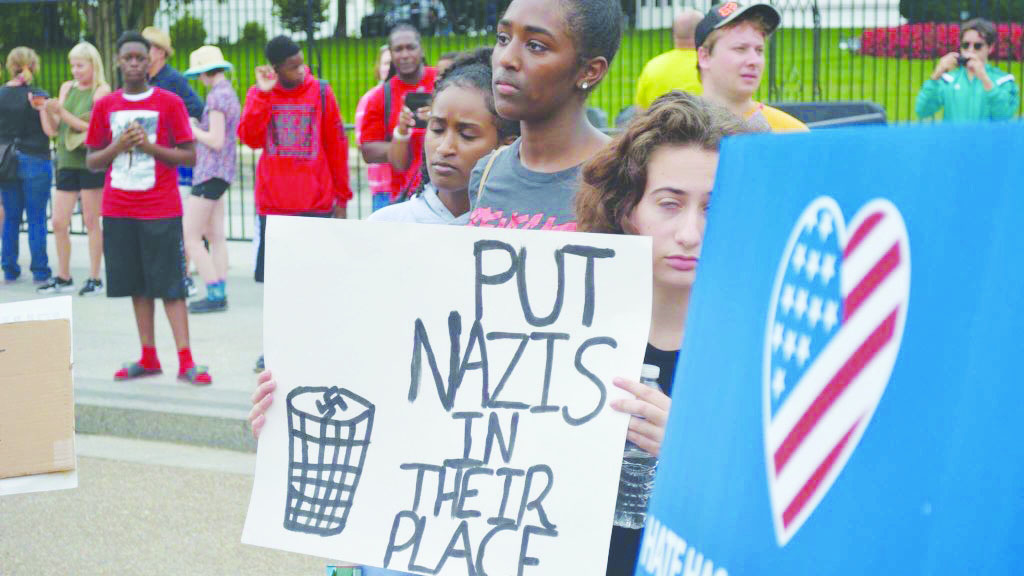Students challenge Confederate symbols
Mayada Hassan (center), a Stuart senior, protests at the “Reject White Supremacy” in Washington D.C. to fight back againt racism in the wake of Charlottesville rally.
“Hey, hey, ho, ho, Donald Trump has got to go,” senior Mayada Hassan yelled as she marched in front of the White House.
Hassan went down to D.C. for the “Reject White Supremacy March” to protest the continuance of Confederate monuments all over the country.
The Aug. 14 protest protest was held in response to the “Unite the Right” rally held in Charlottesville by alt-right supporters in protest of the removal of the Robert E. Lee statue.
Hassan attends Stuart High School, which just decided this past summer to remove the J.E.B. in front of its name, to go in effect in 2019, because J.E.B. Stuart was a Confederate soldier.
Students who originally began the protest two years ago alleged that Stuart’s Confederate history does not align with the school’s values.
The School Board was highly divided on the name change with dozens of community members voicing their opposition to the name change, citing many reasons including the one million dollar cost and the erasure of history.
“I don’t think taking down our history is correct in principle in any capacity,” senior Everett Stenberg said.
Just last summer, the Board agreed in a 10-2 vote to explore the possibility of a name change through a commission. However, the commission could not agree on one set path forward, and concluded with several deferring views.
According to the The Southern Poverty Law Center, a nonprofit that advocates for equal justice, over 100 schools are named after Lee and other Confederate general/leaders, half of them being in Virginia and Texas.
The same report found that at least 109 public schools named after prominent Confederates have large black student populations.
J.E.B. is also one of the most diverse schools in the county with 78 percent of the school population being minorities, and 22 percent of the population registered as white. Supporters of the name change cite that students of color feel uncomfortable to attend a school with such a controversial name.
“JEB Stuart was a confederate general and a racist who does not represent the diversity of school and what we are about” said Hassan.
Stuart is not the only school in Fairfax County that has been subject to criticism for its Confederate name, but Robert E. Lee High school in Springfield is also named after a Confederate general.
Lee is one of the most commemorate Confederate leaders memorialized all over the country not only in the form of school names, but as monuments and statues all over the country.
The SPLC found in their study that over 700 Confederate statues exist on public property.
In recent years, there have been calls for the removal of these Confederate statues and memorials because, to many, these monuments are symbols of white supremacy within the US.
Memorials of leaders like Jefferson Davis and Thomas “Stonewall” Jackson are being taken down all over the country because of their segregationist and slavery ties.
Just as there is support for the removal of these statues, there is equal and possibly more ferocious opposition to the removal of these monuments.
Advocates for the monuments defend the monuments, arguing they are an important symbol of heritage and removing them would be an erasure of history.
“[The statues] are a good reminder of history” Stenberg said. “They depict people who legitimately showed uncommon valor and courage.”
The clash of ideals were seen most tangibly in Charlottesville, VA.
In July, the Loyal Knights of the Ku Klux Klan (KKK) organized a rally to protest the destruction of the Robert E. Lee monument. The Loyal Knights cited their reason for protesting as stopping “cultural genocide.”
The rally garnered a lot of hate and upwards of 500 people came in protest of the 50 person rally.
Later, in August, a rally was formed under the name “Unite the Right” planned to protest the removal of the same statue in Charlottesville.
Described as one of the biggest white supremacist events in US history, the event began on the Friday night before the rally where marchers walked through the University of Virginia’s (UVA) campus. With lit torches, reminiscent of Ku Klux Klan fear tactics used in the 1950s and 60s to incite fear, marchers yelled inflammatory chants like “white lives matter” and “Jews will not replace us.”
Among those who were protesting were so-called alt-right white nationalists, Ku Klux Klan members, and neo-Nazis.
A small group of UVA students protested the night of the rally.
During the rally, many of the white nationalists were wearing Trump paraphernalia; despite the rising tensions in the nation and the numerous politicians and leaders denouncing the rally, Trump took two days to condemn the rally. In several press conferences Trump doubled down on his claim that “both sides” were to blame for the Charlottesville violence.
He even went as far as accusing the left-wing anti-fascist or “antifa” protesters of showing up “without a permit” and said they were “very, very violent.”
The rally continued into Saturday, and led to clashes with counter demonstrators causing a local state of emergency to be called in Charlottesville. Later, the clashes became deadly when James Alex Fields sped his car into anti-racist protestors, killing 32-year-old Heather Hayer and injuring at least 19 others.
Lee is one of the most popular Confederate leaders memorialized in the country, and many of those who oppose the destruction of his statues point out that Lee was not a pro-slavery ideologue, rather they allege he was against slavery. Although, Lee wrote in a letter to the New York Times in 1858 that “ slavery as an institution is a moral and political evil in any country,” Lee’s troops under his command during the war were allowed to raid settlements and capture free blacks for enslavement during major operations like the 1863 invasion of Pennsylvania.
Because of the tensions, UVA covered the statue with black tarp.
Many of the monuments that are up for debate today were erected 100 years ago during Reconstruction, after the Civil War. Many historians say that they were built to intimidate minorities and to serve as a reminder that Southern white elites were still in control.
During Reconstruction, Lee did, however, object to the idea of raising Confederate monuments, writing in 1869 that it would keep “open the sores of war.”
However, it is the argument that Lee has always somehow opposed slavery that helped maintain his stature as a symbol of Southern honor and reconciliation.
In addition to confederate leaders, politicians like Abraham Lincoln and Woodrow Wilson have been have been subject to scrutiny because of their racist ties. People are now considering how much a person’s sacrifice and accomplishments for the country outweigh their racist viewpoints that still underlie today’s society.
Those who advocate for the removalsof such monuments also cite that having large statues of these leaders who symbolize white nationalist ideals of the past, and putting them on public property only strengthens these racist ideals.
However, with increasing tensions, and especially after the Charlottesville events, many colleges and universities are beginning the process of removing their Confederate monuments.
“I want it to be heard that racism is an institution in America, and ignoring it means you are a part of the problem,” Hassan said.

Senior Aseal Saed is currently the Co-Editor in Chief of The A-Blast. This is her fourth year on staff. Her previous positions were as In-Depth Editor...











